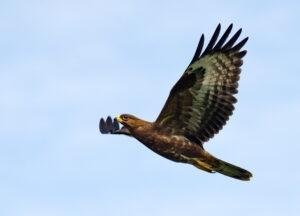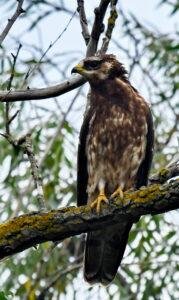The European Honey Buzzard (Pernis apivorus), also known as the Pern or Common Pern, is a bird of prey in the family Accipitridae.
Despite its English name, this species is more closely related to kites of the genera Leptodon and Chondrohierax than to true buzzards in Buteo. The binomen is due to Linné, derived from περνης, an Aristotelian term for a bird of prey, and Latin apivorus “bee-eating” (although bees are much less important than wasps in the bird’s diet).
The European Honey Buzzard is a summer migrant to most of Europe and western Asia, wintering in tropical Africa. It is seen in a wide range of habitats, but generally prefers woodland and exotic plantations.
Being a long distance migrant, the Honey Buzzard relies on magnetic orientation to find its way south, as well as a visual memory of remarkable geographical features such as mountain ranges and rivers, along the way. It avoids large expanses of water over which it cannot soar. Accordingly, great numbers of Honey Buzzards can be seen crossing the Mediterranean sea over its narrowest stretches, such as the Gibraltar Strait, the Bosphorus, or in Israel.
The 52–60-centimetre-long (20–24 in) Honey Buzzard is larger and longer winged, with a 135–150-centimetre (53–59 in) wingspan, when compared to the smaller Common Buzzard Buteo buteo. It appears longer necked with a small head, and soars on flat wings. It has a longer tail, which has fewer bars than the Buteo buzzard, usually with two narrow dark bars and a broad dark sub-terminal bar. The sexes can be distinguished on plumage, which is unusual for a large bird of prey. The male has a blue-grey head, while the female’s head is brown. The female is slightly larger and darker than the male.
The soaring jizz is quite diagnostic; the wings are held straight with the wing tips horizontal or sometimes slightly pointed down. The head protrudes forwards with a slight kink downwards and sometimes a very angular chest can be seen, similar to a Sparrowhawk, although this may not be diagnostic. The angular chest is most pronounced when seen in direct flight with tail narrowed. The call is a clear peee-lu.
It has been suggested that the similarity in plumage between juvenile European Honey Buzzard and Common Buzzard has arisen as a partial protection against predation by Northern Goshawks. Although that formidable predator is capable of killing both species, it is likely to be more cautious about attacking the better protected Buteo species, with its stronger bill and talons. Similar Batesian mimicry is shown by the Asian Pernis species, which resemble the Spizaetus hawk-eagles.
It is sometimes seen soaring in thermals. When flying in wooded vegetation, Honey Buzzards usually fly quite low and perch in mid canopy, holding the body relatively horizontal with tail drooping. The birds also hop from branch to branch, each time flapping their wings once, and so emitting a loud clap. The bird often appears restless with much ruffling of the wings and shifting around on its perch. The Honey Buzzard often inspects possible locations of food from its perch, cocking its head this way and that to get a good look at possible food locations. This behaviour is reminiscent of an inquisitive parrot.
The Honey Buzzard breeds in woodland, and is inconspicuous except in the spring, when the mating display includes wing-clapping. Breeding males are fiercely territorial.
It is a specialist feeder, living mainly on the larvae and nests of wasps and hornets, although it will take small mammals, reptiles and birds. It is the only known predator of the Asian giant hornet. It is thought that Honey Buzzards have a chemical deterrent in their feathers that protects them from wasp attack.





